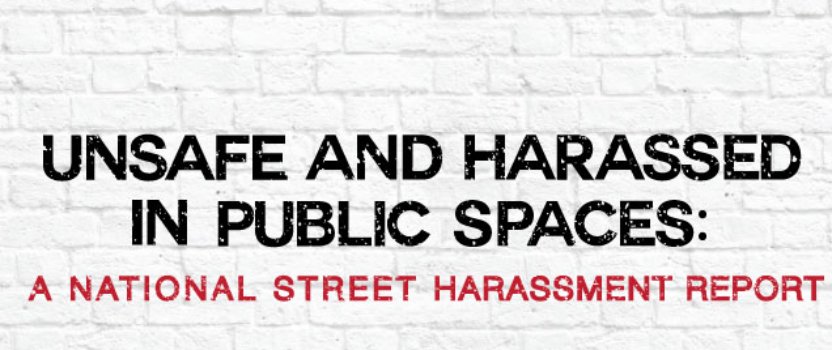New Study Finds High Prevalence of Street Harassment – Here’s What You Can Do To Stop It
A national study released today by our friend and former board member Holly Kearl is the first to quantify the prevalence and harm done by street harassment in our nation. Combined with the innumerable stories shared on the #YesAllWomen hashtag, providing a clear picture of the emotional impact of entitlement and aggression perpetrated across the spectrum of violence, street harassment conversations are entering the mainstream and finally — hopefully — being taken seriously.And importantly, victims of public sexual harassment and assault are learning that they are in the company of a majority of Americans: 65% of women and 25% of men. To me, as someone who talks about these issues often and is always answered by strikingly similar stories (“I was on the subway, trying to get home, when a guy”…;”I was standing on the street corner, and out of nowhere…”; “I feel like I’m running the gauntlet every day…”), these numbers seem low.
Holly’s report confirms a number of things about street harassment that CASS has been teaching people in the DC area for over five years:
- It starts early: Holly finds that 50% of women and men who experienced harassment were first harassed before the age of 17 — even as early as 11 or 12.
- It’s a human rights issue: Men who identified as LGBT were more likely to report harassment than men who identified as heterosexual, showing that harassment is a gender issue writ large.
- It’s not just “street” harassment: Respondents reported being harassed in stores, restaurants, movie theaters, and public transportation.
- It threatens our safety and affects our lives: A majority of respondents who experienced harassment said they were concerned it would escalate into physical violence. And many said they constantly assess their surroundings, travel only in groups, or even move neighborhoods or change jobs to avoid it.
- It reflects other inequalities: People of color, people from low-income communities, and people identifying as LGBTQ were disproportionately impacted by street harassment overall.
The study is an incredible addition to the body of knowledge around street harassment and a powerful argument that this problem deserves the attention of communities across the country. We congratulate Holly and all of Stop Street Harassment for their important work. While many questions are left to be addressed in future studies, one in particular resonates with us: what are we going to do about it?
Our answer? Collective action! With a problem so big, so normalized, so highly prevalent, and so damaging to individuals and the neighborhoods they live and work in, the only sustainable solution is community-driven culture change. This means that everyone, regardless of status or identity, has a part to play in ending street harassment. Indeed, it takes a village to build a community where people of all backgrounds, gender expressions or identities, and experiences can feel safe occupying public spaces.
Thousands of people here in the nation’s capital have already undertaken the daunting task of culture change, and at CASS we have witnessed first-hand the power we have when we take collective action. Here are some examples:
PREVENTING SEXUAL HARASSMENT & ASSAULT ON METRO
After mobilizing the community to show policymakers that sexual harassment on public transit is a serious problem, CASS has worked with the Washington Metropolitan Area Transit Authority (WMATA) to implement policies and programming to prevent sexual harassment and assault on DC’s public transit system.
TRAINING NEW ANTI-HARASSMENT ACTIVISTS
CASS holds innovative workshops to empower the community to take action to prevent public sexual harassment and assault, challenging harmful social norms that propagate gender-based violence and developing concrete skills to respond to street harassment on both an individual and community level. So far, we’ve trained hundreds of new anti-harassment activists all over DC.
MAKING BARS SAFER SPACES
Bar staff should be at the front lines of sexual violence prevention, but businesses are typically overlooked as stakeholders in culture change. Safe Bars, a project of CASS and Defend Yourself, trains and empowers staff at alcohol-serving establishments to recognize and respond to incidents of sexual harassment and assault among patrons and staff.
SHARING STORIES TO SPUR ACTION
CASS’s blog provides a platform for personal stories of gender-based public sexual harassment and assault DC, documenting the issue and building a community dedicated to its prevention.
ADVOCATING FOR SURVIVORS
CASS is a founding member of the DC Justice for Survivors Campaign, which, in an unprecedented survivor-led effort, successfully pushed for wide-ranging changes in the way DC police handle sexual assault complaints. We continue to facilitate spaces for survivors to engage with the systems meant to serve them.
PROVIDING SAFE TRAVEL OPTIONS FOR WOMEN & LGBT FOLKS
Too often, the solution to keeping yourself safe from harassment and assault put forth by authorities and policymakers is to limit your movements at night or take private transportation. But this fails to protect people who can’t make those changes for economic or other reasons. We are raising funds to implement a program called RightRidesDC, which will provide safe, free late-night rides home to women and LGBTQGNC individuals on weekends.
The best solutions to ending street harassment are the ones that you haven’t thought of yet. Check out Stop Street Harassment’s groundbreaking new study — and then go out into your neighborhood and take action!
Recommended Reading:
7 Steps You Can Take To Address Street Harassment
5 Excuses for Street Harassment We Need To Stop Making…Now
Statistics: Here’s Why Street Harassment is a Big Deal

